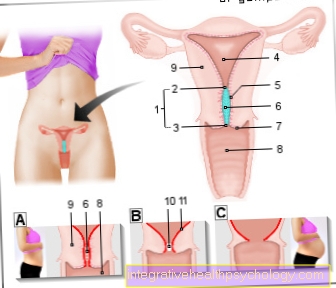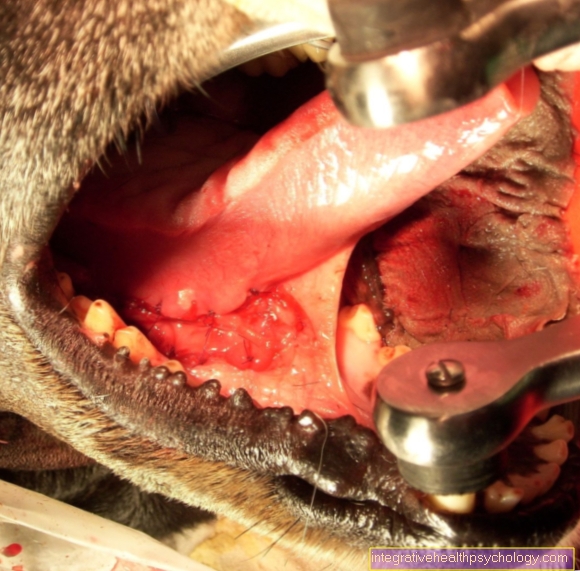Lens opacity - cataracts
synonym
Lens opacity, cataract = cataract (med.)
Definition - what is lens opacification?
Lens opacity is when the lens, an important component of the eye for seeing, is no longer transparent, but opacified. This cloudiness is often grayish, which is why the lens cloudiness is still popularly referred to as "cataracts" today. In medicine, the clouding of the lens is called "cataract". Lens clouding usually occurs as a result of aging, but it can also be caused, for example, by medication or an accident. If there is a significant impairment of vision due to the clouding of the lens, surgical therapy is used, which usually increases the quality of life of those affected significantly again.

Detecting lens opacification
What are the symptoms of lens opacification?
When the lens is cloudy, symptoms are usually quite characteristic. In the most common form of lens opacity, i.e. senile lens opacity as part of aging, the symptoms appear gradually over several years and become more and more pronounced.
The symptoms of lens opacification include deterioration in vision because the lens is no longer transparent and the light from outside falls into the eye more difficultly. There is an increasing sensation of glare, so the light is perceived as brighter and more unpleasant. Furthermore, it can lead to changed vision of colors and, in the advanced stage, to increasing gray vision. In some cases, double vision also occurs as the lens opacity progresses.
In the rarer form of a congenital, i.e. congenital, lens opacity, on the other hand, there may be a lack of red light reflection in a photo and squinting.
For more information, see: Cataract symptoms
How is lens opacification diagnosed?
The diagnosis of lens opacification is usually made by an ophthalmologist. For this purpose, an examination with a so-called slit lamp is usually carried out. This is a light device often used by ophthalmologists to examine the eye. A clouding of the lens, usually gray-brownish, possibly also yellowish, can be determined. In the case of advanced lens opacities, opacity of the lens can be recognized even without examination equipment.In addition, vision tests can be used to determine impaired vision due to the clouding of the lens.
Treating lens opacification
How is lens opacification treated?
As a rule, lens opacities are treated surgically. A cure for the clouding of the lens cannot be achieved with medication.
There are several surgical options for treating lens opacification. First of all, it must always be asked whether the operation makes sense. This is the case with a significant deterioration in vision with impairment in everyday life. The most common method used today is the so-called extracapsular cataract extraction. The front section of the lens, the so-called front capsule, is opened through a very small incision. Then the core of the lens (the area of the lens that usually contains the greatest opacity) is liquefied by a powerful ultrasound device. This liquefaction of the lens nucleus by ultrasound, which was specially developed for cataract surgery, is also known as phacoemulsification. The core is then removed and a posterior chamber lens is inserted to stabilize the posterior section of the lens, the so-called posterior capsule. This operation is one of the most common in the world today and usually has a very good prognosis. In approx. 30% of the cases, a secondary cataract, i.e. a return of the lens opacity, can occur.
For more information, we recommend our website to: Cataract treatment or cataract surgery
Preventing lens opacification
What are the causes of lens opacification?
The causes of lens opacification can be very diverse. First of all, a distinction can be made between congenital lens opacities, so-called congenital forms, and acquired forms. The congenital form makes up less than 1% of all lens opacities and can either be inherited or caused by an infection during pregnancy or childbirth.
The far more common form is acquired lens opacification. Of these, over 90% are in turn a senile lens opacity. This is a clouding of the lens as part of natural aging. The exact mechanisms are not fully understood, presumably there is a reduced nutrition of the lens with nutrients. Often other underlying diseases, such as diabetes mellitus or kidney failure, also play a role. In rare cases, however, these can cause clouding of the lens without the aging process. Other causes of acquired lens opacity can be medications such as cortisone. An accident with a bruised eye can also cloud the lens. Very rarely, lens opacities can also occur in the course of an operation on the eye or due to radiation such as X-rays or infrared radiation.
For more information, see: Causes of lens opacification
Course of a lens opacification
What is the prognosis for lens opacification?
The prognosis of lens opacification depends on whether an operation needs to be performed and, if so, how it will proceed. In most cases, surgery can bring about a significant improvement in vision and, as a result, a better quality of life.
Without surgery, there can be a complete loss of vision in an advanced stage. In addition, glaucoma, formerly known as "glaucoma", is a possible consequence of failure to receive therapy.
Also read: Green Star
Further questions about lens opacity
Is lens opacification a possible complication after cataract surgery?
A possible complication of a lens opacification operation is a recurring lens opacity. This occurs in around 30% of those affected who have had what is known as an extracapsular cataract extraction. This is the most common surgical method for opacified lenses.
Among other things, a posterior chamber lens is used to stabilize the rear section of the lens, the so-called rear capsule. After the operation, an increase in the number of cells on the lens surface, the so-called lens epithelium, can lead to renewed lens opacity. The cells migrate into the operated lens and thus lead to renewed clouding of the lens. This is also referred to as "post-cataract".
There is also a special surgical procedure for this to remove this renewed lens opacity. A so-called YAG laser, a special laser for the lens, is used. This time the posterior capsule of the lens is opened and the excessively accumulated cells are destroyed with the help of the laser.
Is there lens opacification from medication?
Lens opacity can occur as a side effect of various medications. These include, for example, the glucocorticoids with cortisone as the most common representative. But also so-called miotics, i.e. drugs that ensure a temporary reduction in the size of the pupil - as part of diagnostic and therapeutic examinations - can lead to lens opacity when used over a long period of time. Furthermore, in rare cases, poisoning, for example ammonia poisoning, can lead to a cataract.
Lens opacity from cortisone
In a few cases, drugs such as cortisone can also cause the lens to become cloudy. The exact mechanisms are not yet understood. Both local and systemic cortisone treatment can lead to lens opacity. A local treatment would be, for example, an injection with a syringe or the application of an ointment to the eye as part of an infection. In contrast, systemic treatment refers to the administration of cortisone into the vein or the intake of cortisone tablets, for example in the case of lung disease.
Does a lens opacification also occur in babies?
In rare cases, the baby's lens can become cloudy. This type of lens opacification is also known as the congenital form, which means something like "innate". The clouding of the lenses in babies can either be inherited or caused by an infection during pregnancy or childbirth. The most common infections include rubella, mumps and hepatitis. In rare cases, a so-called galactosemia, a metabolic disorder in the breakdown of sugar, can also be the cause.
One of the symptoms of clouding of the lens in babies is the so-called leukocoria, i.e. the absence of the red light reflex of the retina, which can be easily seen when taking photos, for example. In addition, there is a squint and a delay in the development of the child because the eyesight is impaired.
Depending on the degree of cloudiness in the baby's lens, surgical therapy is also carried out here. If the lens is cloudy due to galactosemia, it can be completely reduced by a galactose-free diet.





























